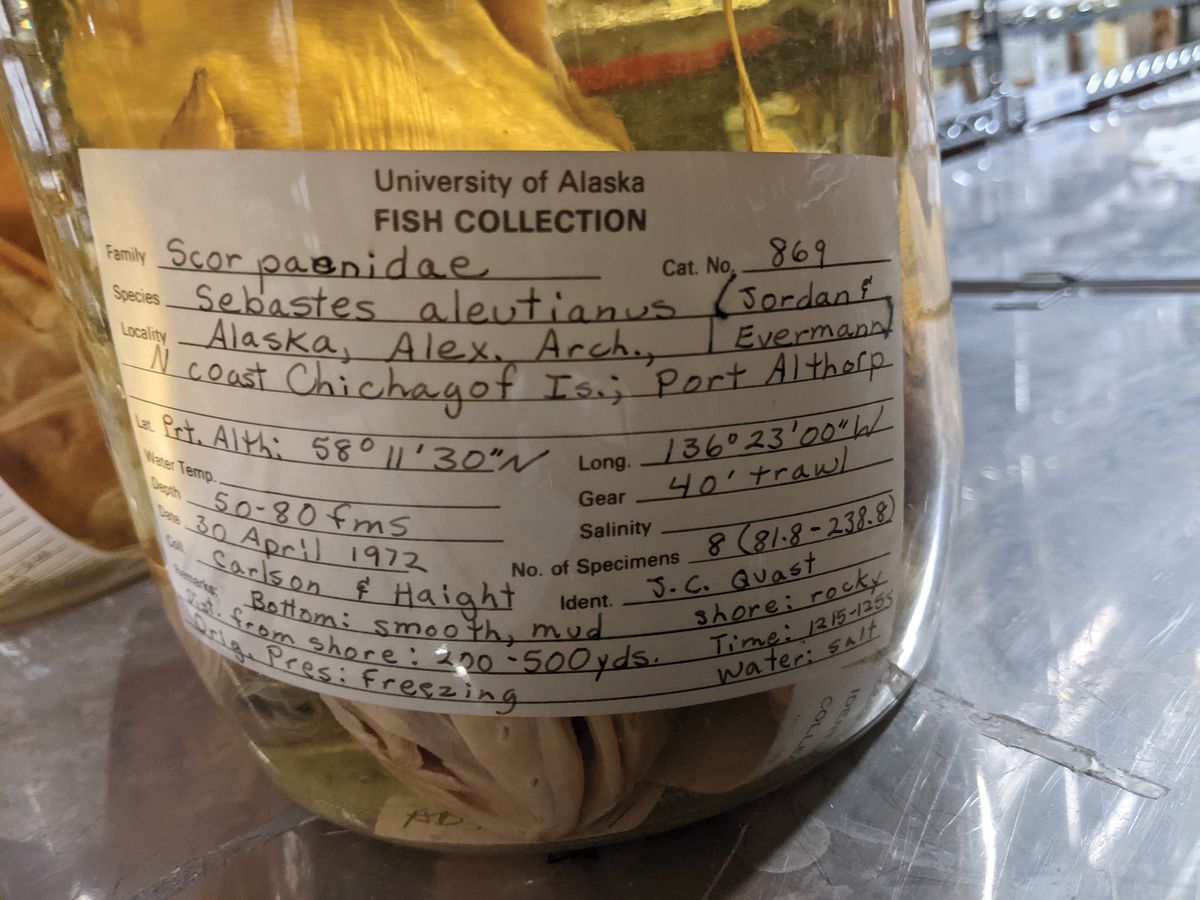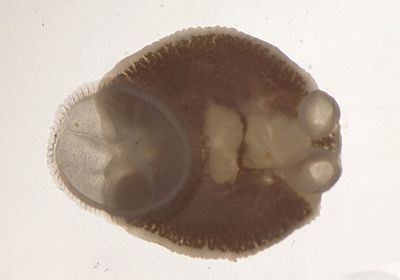ABOVE: A monogenean flatworm, a common fish parasite, under magnification Katie Leslie
Situated on the Seattle campus of the University of Washington, the Burke Museum hosts the largest repository of preserved fish in North America. More than 400,000 individuals representing 4,100 species line the shelves of the museum’s ichthyology collection. Preserved in ethanol, these specimens are a window into the marine and freshwater ecosystems of the past. For University of Washington (UW) ecologist Chelsea Wood, however, the most interesting things in those thousands of jars aren’t the fish themselves, but the parasites they carried in and on their bodies.
Wood and her lab are studying these tiny creatures to answer a long-debated question: How has the abundance of parasites changed over time? “Until recently, I didn’t think that there was ever a way that we were going to find answers to that question,” Wood says. Many ecologists have worked under the assumption that parasite loads in the past were lower than today, she explains. That’s because parasite abundance is often seen as a sign of stress, as hosts may be less able to control their parasite loads when faced with stressors such as food shortages or pollution—conditions that have intensified in many regions in recent years.
But that assumption has remained untested, with very little data to support or refute it. While previous studies have been able to detect parasites in preserved fish specimens—some of them years or centuries old—those studies gave little insight into the parasites’ abundance. The problem, Wood explains, was that there was no way to verify whether the steps taken to preserve those specimens were affecting the number of parasites detectable on them.
In 2020, Wood and her team found a way to collect those data. They took fresh fish of three species and preserved some of them in ethanol, the same method used by the Burke and other museums around the world. Several days later, the researchers compared the parasite counts from these experimentally preserved fish to counts from fresh specimens they dissected right away and, for the first time, confirmed that the preservation process did not bias the numbers. This validation study meant that any fish preserved and stored this way—potentially millions of specimens in museums around the world—could be used to study the question of past parasite abundance, Wood says.

To get accurate counts of these tiny creatures, Wood’s lab used a variation on an established methodology that entails cutting filets from preserved fish and flattening the muscle tissue between glass plates to detect parasites. Wood’s team made an incision and spread the body cavity open, then shone a powerful light through the fish’s side. Parasites showed up as shadows against the light background of the preserved muscle, allowing the researchers to remove and identify them under a magnifying glass or microscope.
While previous studies have been able to detect parasites in preserved fish specimens—some of them years or centuries old—those studies gave little insight into the parasites’ abundance.
Over the past few years, the lab has continued to refine the technique and apply it to a greater number and variety of samples. In a recent paper published in the Journal of Animal Ecology, Wood explores how such methodology could help researchers address ecological questions about not only fish but other aquatic taxa. The paper presents historical parasite ecology as a new subdiscipline addressing the abundance of parasites in the past as well as biotic and abiotic factors that act on their populations, both then and now. As the method is applied more widely, it is challenging, or at least complicating, the assumption that early seas were less parasite-dense. Quite the opposite, “our research suggests that a lot of metazoan parasites are diminishing in abundance,” says Wood.
Joshua Brian, a postdoctoral research associate at King’s College London who was not involved in the research, says the team put together “a brilliant paper.” Brian studies host-parasite interactions in freshwater mussels, with a focus on these small and unbeloved parasite species’ vulnerability to extinction. “These sorts of methods, to look back in the past at where parasites were and what their abundance was, and linking that with host variability, environmental variability, it’s just so important to start to build this picture about how parasites are changing,” adds Brian.

The Wood lab is now working on its largest analysis of fish parasites yet, covering dozens of parasite species and spanning 130 years of the history of Puget Sound in the Pacific Northwest. Wood says she expects the upcoming study to provide much more insight into ecological change for both parasites and their hosts over the past century.
In addition to preserved fish, museum-kept mammal specimens are also proving to be useful for the historical study of parasites and disease. In a recent paper, researchers from the University of Richmond extracted bacterial DNA from mammal skins to learn more about the spread of Lyme disease through the eastern United States. By testing mouse specimens—and the ticks they carried—from the mammalogy collection of the Virginia Museum of Natural History, the paper’s authors were able to trace the spread of the Lyme disease–causing bacterium (Borrelia burgdorferi) southward over the past few decades.
“Specimens are collected and archived for one reason, and turn out to be incredibly valuable historical records for other studies,” explains coauthor Nancy Moncrief, the Virginia Museum’s curator of mammalogy. She collected some of the mouse specimens used in the study herself, for research that had nothing to do with Lyme disease. “We can’t predict what technology is going to be here in ten years, but we’ve archived the samples and documented them correctly, to be able to answer those questions.”
Wood notes that this is an advantage of her lab’s less invasive methodology for dissecting fish: it minimizes damage to the irreplaceable original specimens. Everything used in the lab’s studies goes right back into the museum collections, down to the last tiny parasite (labeled and stored separately from the source specimen), leaving them available for future researchers to explore questions of their own.
The only concrete limits on what can be done with museum specimens are what samples make it into a collection, and the survival of the collections themselves. “Not as much material is being archived,” says Moncrief, pointing to a decline in new museum collections and a worrying trend of smaller collections—particularly at struggling universities—closing their doors. “You can’t go back in time,” she adds, but museum specimens offer a rare glimpse into the past. As long as the collections survive, their applications should only continue to grow.

